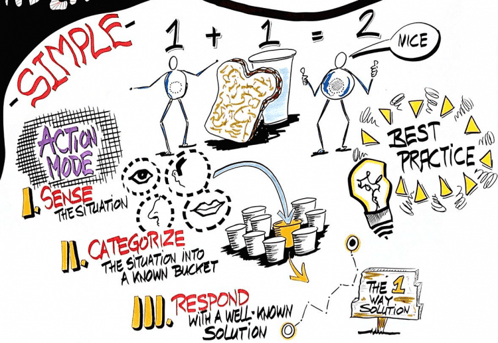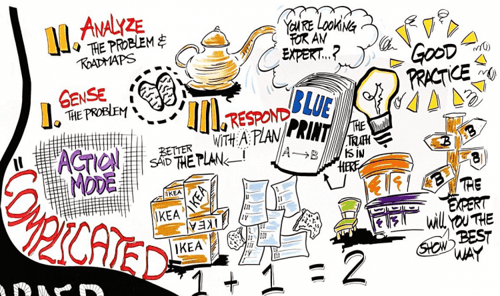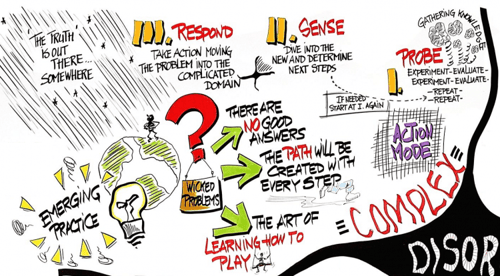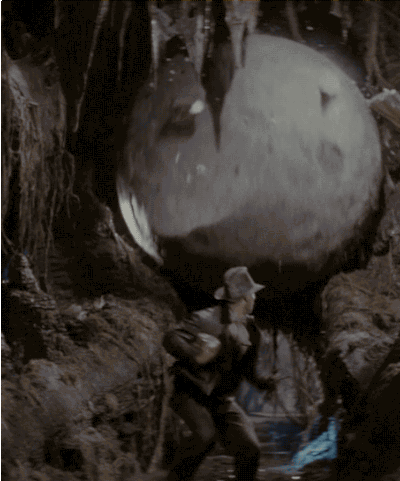President and Cofounder, Partner
Adaptability in times of chaos
President and Cofounder, Partner
I don’t need to tell you these are strange, possibly unprecedented times for businesses. Things were complicated enough a few months ago, but at this point we’ve sailed past complicated and landed at the edge of chaos.
This situation has gotten me doing a lot of thinking and talking with the rest of the team
I’ve been doing a lot of thinking about our situation, and talking it over with my fellow managers and the rest of the team. How should we be reacting? What moves are the right ones to make in an ecosystem where the rules of the game change every week, sometimes every day?
I’m a big fan of frameworks to help clarify my thinking. Several years ago, Simon Éthier, a longtime colleague and VP, Consulting here at Adviso, introduced me to the Cynefin framework. At the time, our goal was to determine the best services to offer clients based on the system they had in place.
However, this framework is also extremely useful for thinking your way through the thick fog brought on by the pandemic.
For those who aren’t familiar, the Cynefin framework helps to define the characteristics of the system we’re in, to identify the most appropriate plan of action:
- A simple system contains known variables, and we should be creating action plans based on best practices. For example, improving the quality of a landing page to increase conversion rates or reduce acquisition costs.

- A complicated system contains unknown variables, but experts are available to help us analyze the situation and determine a plan of action. This plan, based on good practice, won’t necessarily be agreed upon unanimously by experts. That said, it has a strong chance of working. For example, improving a site’s SEO might fall here. In this system, we’ll see different experts recommending different courses of action, but in spite of the lack of uniformity in the plans laid out to us, we are likely to see results.

- A complex system requires an element of instinct, and trial and error, because there are no experts to help with the analysis. We need to listen, probe and experiment constantly for the rules of the system to start to emerge: we need to reverse-engineer the system in order to understand it. I’m referring here to emerging practices. In my opinion, this is the system the global pandemic has landed us in now. Because no one knows exactly what will happen to the economy, certain industries and the way we work.

- A chaotic system gives us no time to think. It’s like when Indiana Jones is running away from the giant boulder trying to crush him, and he comes to a cliff… In a situation like that, we act almost without thinking.

The idea is to look at problems one by one and try to roll the system back to the preceding quadrant. In this instance for example, we want to go from complex to complicated.
The simple fact of admitting that we’re in a complex system and accepting that “we don’t know what we don’t know” can be beneficial; it allows us to take a breath before taking the next steps.
How do you navigate a complex system ?
To move from a complex system to a complicated one, Cynefin teaches us to be active. Listen, probe, try things, learn, observe, make mistakes, start over, refine. All these verbs imply a proactivity that allows practices to emerge that eventually become good practices. This proactivity also allows us to arrive at a system that’s a bit easier to manage.
Many companies, executives and organizations have had a hard time applying this approach after realizing they were in a complex system where the rules and codes haven’t yet been written. An example of this is our education system during the pandemic. As a parent, I’ve been disappointed to witness the inaction of those in charge, at the cost of our children’s education.
The tone was set when the education minister suggested “taking a vacation for the first two weeks,” and the inaction that followed did little for our children, while utterly depleting our teachers and school administrators. Misguided proactiveness would at least have had the merit of building up the adaptability of teachers, administrators, parents and children, in other words those people who make up the system.
It was of course impossible to predict what would happen given the system they were in. But the lack of action paralysed everyone involved. And many simply didn’t develop any ability to adapt.
Schools weren’t alone. Many other organizations also failed to act in the face of sudden changes in consumption, in addition to widespread closures, new laws and changes in the market.
That said, even well before the pandemic a majority of organizations had no idea how to adapt to the complicated systems they existed in. A system made up of new business models, competitors and ways of doing things, all triggered by the advent of digital. These organizations had taken no steps to establish a game plan for their digital shift, in spite of the availability of experts able to provide guidance and help them adopt the best practices.
Adaptability
The more I think about it, the more I’m convinced that adaptability is the top quality any modern company, executive or employee must have. Our world is in a state of perpetual flux, and it’s accelerating constantly.
Teachers refusing to set up Zoom meetings with students because they have no Internet connection, or because it’s different from the way they’ve always done things, is a clear example.
On the flip side, people who embrace uncertainty, try new ways of doing things and explore new terrain are the ones best positioned to advance the system and their organizations.
The time to develop adaptability is now
If you work for an organization that doesn’t prioritize adaptability, don’t give up hope. Situations like the one we’re currently in offer unique opportunities to change things.
Companies that haven’t invested in digital transformation are often resistant, putting change off until a later date. Why change, refine, make sacrifices or revisit a winning formula? The status quo is far less risky. But of course, the less you adapt, the less adaptable you become.
If there’s one advantage of this pandemic, it’s that sacrifice and adaptability are now necessary qualities for life and even survival. It’s a blessing for those who are able to seize the opportunity. Trade shows are the perfect example. Many companies find prospects by attending dozens of trade shows each year, spending hundreds of thousands of dollars in the process. Spending trade show budgets will be virtually impossible in the months and years to come, which means finding new business opportunities will be more important than ever.
The time to make the long-delayed shift to digital is now. Now is the ideal time to adapt and, in doing so, move from a complex system to a complicated one.
-1.png)








